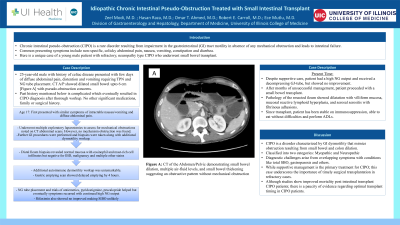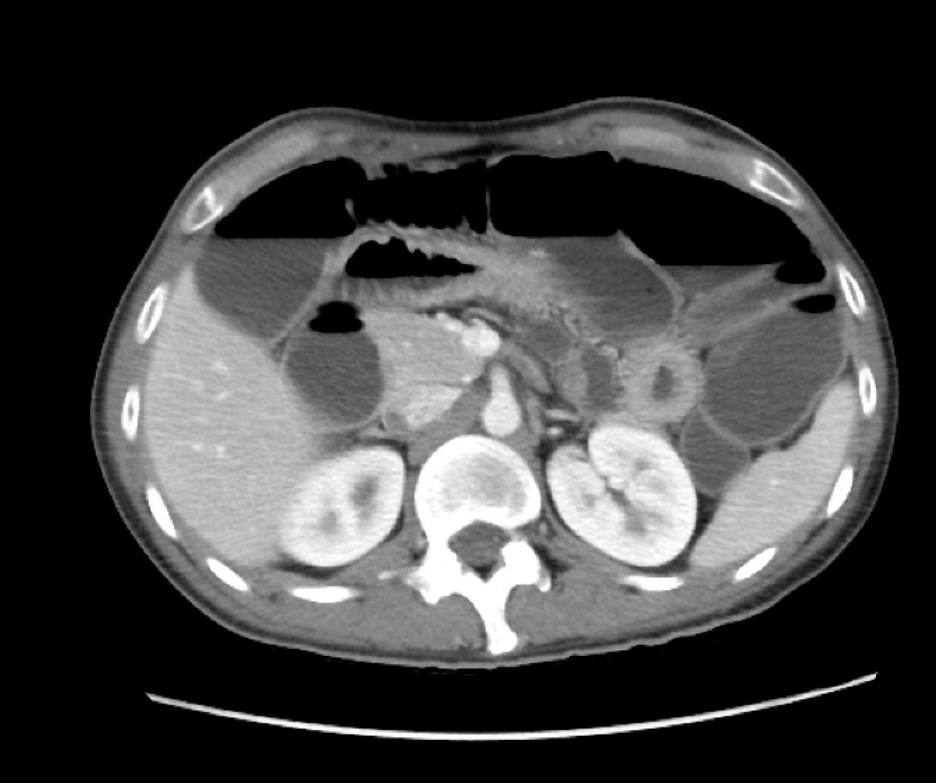Monday Poster Session
Category: Small Intestine
P3243 - Idiopathic Chronic Intestinal Pseudo-Obstruction Treated With Small Intestinal Transplant
Monday, October 28, 2024
10:30 AM - 4:00 PM ET
Location: Exhibit Hall E

Has Audio

Zeel N. Modi, MD
University of Illinois
Chicago, IL
Presenting Author(s)
Zeel N. Modi, MD1, Hasan S. Raza, MD1, Omar T. Ahmed, MD2, Ece Mutlu, MD1, Robert E.. Carroll, MD2
1University of Illinois, Chicago, IL; 2University of Illinois at Chicago, Chicago, IL
Introduction: Chronic intestinal pseudo-obstruction (CIPO) is a syndrome of abnormal gut motility in the absence of mechanical obstruction leading to intestinal failure. CIPO cases are sporadic, and biopsies help classify them further. Multifactorial treatment is usually unsatisfactory with poor outcomes. We present a rare case of a young male with refractory, neuropathy type CIPO who underwent a small bowel transplant.
Case Description/Methods: A 25-year-old male with a history of celiac disease presented with diffuse abdominal pain, distention, and vomiting necessitating TPN from inability to tolerate an oral diet. Since age 17, he underwent multiple exploratory laparotomies to assess for mechanical obstruction suggested by CT scans; however, these surgeries were unrevealing. He was also evaluated at two other intestinal motility centers. Workup included endoscopies and an enteroscopy with no evidence of GI tract stenosis or inflammatory bowel disease (IBD). A full-thickness small bowel biopsy in the distal ileum revealed a normal ileum with eosinophil and mast cell-rich cell infiltrates; negative for IBD, malignancy, and granuloma; negative for amyloid by congo red stain; mildly increased fibrosis by trichrome stain; and was deemed nondiagnostic by pathologists. Additional testing ruled out autoimmune etiologies for dysmotility. A gastric emptying scan showed delayed emptying at 4 hours. There was no improvement after rifaximin for presumed small intestinal bacterial overgrowth. A diagnosis of CIPO was made. Over four months, his symptoms worsened despite TPN. An NG tube was placed with persistent high output and symptoms despite trials of antiemetics, pyridostigmine, prucalopride, and decompressing GJ-tube. CT A/P showed dilated small bowel loops upto 6.0 cm with concerns for pseudo-obstruction (Figure A). The inability to wean TPN led to a small bowel transplant. The full-thickness resected ileum showed dilatation with villiform mucosa, mucosal reactive lymphoid hyperplasia, and serosal serositis with fibrinous adhesions. The duodenal full-thickness specimen was normal. Post-surgery, he successfully tolerated an oral diet.
Discussion: Owing to its rarity, CIPO remains a diagnostic challenge. Our patient underwent an extensive workup with no clear etiologies for CIPO and eventually had a small bowel transplant. This is a unique case as it demonstrates the disease severity while highlighting the need for research on optimal surgical timing to initiate small bowel transplant evaluation for CIPO patients.

Disclosures:
Zeel N. Modi, MD1, Hasan S. Raza, MD1, Omar T. Ahmed, MD2, Ece Mutlu, MD1, Robert E.. Carroll, MD2. P3243 - Idiopathic Chronic Intestinal Pseudo-Obstruction Treated With Small Intestinal Transplant, ACG 2024 Annual Scientific Meeting Abstracts. Philadelphia, PA: American College of Gastroenterology.
1University of Illinois, Chicago, IL; 2University of Illinois at Chicago, Chicago, IL
Introduction: Chronic intestinal pseudo-obstruction (CIPO) is a syndrome of abnormal gut motility in the absence of mechanical obstruction leading to intestinal failure. CIPO cases are sporadic, and biopsies help classify them further. Multifactorial treatment is usually unsatisfactory with poor outcomes. We present a rare case of a young male with refractory, neuropathy type CIPO who underwent a small bowel transplant.
Case Description/Methods: A 25-year-old male with a history of celiac disease presented with diffuse abdominal pain, distention, and vomiting necessitating TPN from inability to tolerate an oral diet. Since age 17, he underwent multiple exploratory laparotomies to assess for mechanical obstruction suggested by CT scans; however, these surgeries were unrevealing. He was also evaluated at two other intestinal motility centers. Workup included endoscopies and an enteroscopy with no evidence of GI tract stenosis or inflammatory bowel disease (IBD). A full-thickness small bowel biopsy in the distal ileum revealed a normal ileum with eosinophil and mast cell-rich cell infiltrates; negative for IBD, malignancy, and granuloma; negative for amyloid by congo red stain; mildly increased fibrosis by trichrome stain; and was deemed nondiagnostic by pathologists. Additional testing ruled out autoimmune etiologies for dysmotility. A gastric emptying scan showed delayed emptying at 4 hours. There was no improvement after rifaximin for presumed small intestinal bacterial overgrowth. A diagnosis of CIPO was made. Over four months, his symptoms worsened despite TPN. An NG tube was placed with persistent high output and symptoms despite trials of antiemetics, pyridostigmine, prucalopride, and decompressing GJ-tube. CT A/P showed dilated small bowel loops upto 6.0 cm with concerns for pseudo-obstruction (Figure A). The inability to wean TPN led to a small bowel transplant. The full-thickness resected ileum showed dilatation with villiform mucosa, mucosal reactive lymphoid hyperplasia, and serosal serositis with fibrinous adhesions. The duodenal full-thickness specimen was normal. Post-surgery, he successfully tolerated an oral diet.
Discussion: Owing to its rarity, CIPO remains a diagnostic challenge. Our patient underwent an extensive workup with no clear etiologies for CIPO and eventually had a small bowel transplant. This is a unique case as it demonstrates the disease severity while highlighting the need for research on optimal surgical timing to initiate small bowel transplant evaluation for CIPO patients.

Figure: Contrast-enhanced CT Abdomen/Pelvis demonstrating small bowel dilatation, multiple air-fluid levels, and small bowel wall thickening suggesting an obstructive process without mechanical obstruction
Disclosures:
Zeel Modi indicated no relevant financial relationships.
Hasan Raza indicated no relevant financial relationships.
Omar Ahmed indicated no relevant financial relationships.
Ece Mutlu indicated no relevant financial relationships.
Robert Carroll indicated no relevant financial relationships.
Zeel N. Modi, MD1, Hasan S. Raza, MD1, Omar T. Ahmed, MD2, Ece Mutlu, MD1, Robert E.. Carroll, MD2. P3243 - Idiopathic Chronic Intestinal Pseudo-Obstruction Treated With Small Intestinal Transplant, ACG 2024 Annual Scientific Meeting Abstracts. Philadelphia, PA: American College of Gastroenterology.
